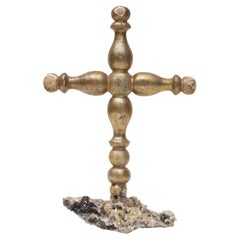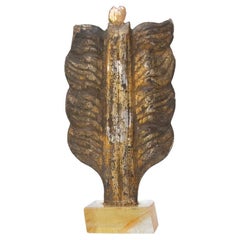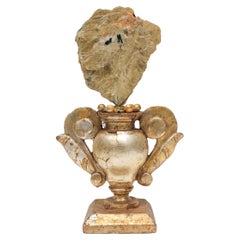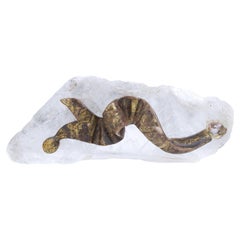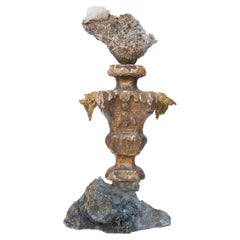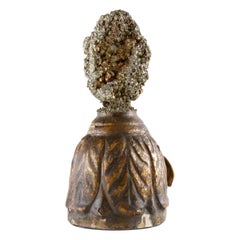Rock Crystal Mounted Objects
to
74
135
14
6
118
3
14
20
1
2
1
99
13
11
1
1
3,801
1,203
1,124
700
417
149
4
124
116
18
16
8
Height
to
Width
to
155
155
155
128
7
2
Material: Rock Crystal
18th Century Italian Cross Mounted on Calcite Crystals in Matrix
By Interi
Located in Dublin, Dalkey
18th century Italian mecca processional cross on a calcite crystal base in matrix with coordinating baroque pearls.
The calcite crystal cluster in matrix is from Elmwood Mine in T...
Category
18th Century Italian Rococo Antique Rock Crystal Mounted Objects
Materials
Rock Crystal
$746 Sale Price
25% Off
Sculptural 18th Century Italian Mecca Arrow on a Polished Calcite Base
By Interi
Located in Dublin, Dalkey
18th-century distressed Italian mecca arrow with a baroque pearl on a polished calcite base.
The arrow was once part of a decorative motif in an artistic depiction in historic Itali...
Category
18th Century Italian Rococo Antique Rock Crystal Mounted Objects
Materials
Rock Crystal, Gold Leaf
$712 Sale Price
25% Off
18th Century Italian Mecca Vase with Mica, Tourmaline, and Baroque Pearls
By Interi
Located in Dublin, Dalkey
Sculptural 18th century Italian mecca vase mounted with mica and tourmaline and adorned natural-forming baroque pearls. The mica and baroque pearls perfe...
Category
18th Century Italian Rococo Antique Rock Crystal Mounted Objects
Materials
Rock Crystal, Gold Leaf
$937 Sale Price
25% Off
18th Century Italian Ribbon Fragment with Baroque Pearls on Selenite
By Interi
Located in Dublin, Dalkey
Sculptural 18th century Italian ribbon fragment with natural-forming baroque pearls on a selenite slab.
The Italian ribbon fragment original came from a...
Category
18th Century Italian Rococo Antique Rock Crystal Mounted Objects
Materials
Rock Crystal
$937 Sale Price
25% Off
18th Century Italian Fragment with Chalcopyrite, Calcite Crystals, and Kyanite
By Interi
Located in Dublin, Dalkey
Sculptural 18th century Italian fragment with chalcopyrite on a druzy crystal matrix with calcite crystals and gold-plate kyanite.
Th...
Category
18th Century Italian Baroque Antique Rock Crystal Mounted Objects
Materials
Rock Crystal
$937 Sale Price
25% Off
18th Century Italian Fragment with Pyrite and a Baroque Pearl on a Lucite Base
By Interi
Located in Dublin, Dalkey
Sculptural 18th century Italian fragment base with coordinating pyrite and a baroque pearl on a lucite base. The fragment was originally part of a hand-carved piece in a historical I...
Category
18th Century Italian Rococo Antique Rock Crystal Mounted Objects
Materials
Rock Crystal, Pyrite
$671 Sale Price
25% Off
18th Century Italian Gilded Fragment with Chalcopyrite and Pyrite in Matrix
By Interi
Located in Dublin, Dalkey
Sculptural 18th century Italian gilded candlestick with pyrite in matrix on a coordinating chalcopyrite mineral base.
The gilded fragment was originally part of a candlestick in a ...
Category
18th Century Italian Rococo Antique Rock Crystal Mounted Objects
Materials
Rock Crystal, Pyrite
$937 Sale Price
25% Off
18th Century Italian Gilded Candlestick Fragment with Pyrite in Matrix on Agate
By Interi
Located in Dublin, Dalkey
18th-century Italian gilded candlestick fragment with pyrite in matrix on a polished agate base.
The fragment was originally part of a candlestick in a historical Italian church in ...
Category
18th Century Italian Rococo Antique Rock Crystal Mounted Objects
Materials
Rock Crystal, Pyrite, Gold Leaf
$937 Sale Price
25% Off
Sculptural 18th Century Italian Candlestick Fragment with Galena and Pyrite
By Interi
Located in Dublin, Dalkey
Sculptural 18th century Italian candlestick mounted with galena and pyrite deposits.
The gilded fragment was originally part of a candlestick in a historical Italian church in Italy...
Category
18th Century Italian Rococo Antique Rock Crystal Mounted Objects
Materials
Rock Crystal, Pyrite, Gold Leaf
$1,162 Sale Price
25% Off
Sculptural 18th Century Italian Mecca Gilt Arrow on a Polished Calcite Base
By Interi
Located in Dublin, Dalkey
18th-century distressed Italian mecca gilt arrow with a baroque pearl on a polished calcite base.
The arrow was once part of a decorative motif in an artistic depiction in historic ...
Category
18th Century Italian Rococo Antique Rock Crystal Mounted Objects
Materials
Rock Crystal, Gold Leaf
$787 Sale Price
25% Off
18th Century Italian 'Florence Fragment' with a Chalcedony Rosette
By Interi
Located in Dublin, Dalkey
17th century Italian fragment with a chalcedony rosette. It has antique hand-written Italian inscriptions on the base. The chalcedony mineral mimics the color and texture of the distressed wood fragment.
This fragment is from a church in Florence. It was found and saved from the historic Florence Flood of 1966. This was one of the worst floods recorded since the Renaissance and drew thousands of volunteers from all over the world to help save the city known for its precious history, artwork, artifacts, and rare books. The volunteers were called "the mud angels" because of the mud and silt left everything from the damage of the flood. There is still the original paint and silt left on the piece to uphold the integrity, craftmanship, and history of sculptural fragment.
The story and history of this piece and Interi's collection of Florence fragments...
Category
18th Century Italian Rococo Antique Rock Crystal Mounted Objects
Materials
Rock Crystal
$671 Sale Price
25% Off
Sculptural Tree with an 18th Century Italian Miniature Helmet Mounted on Calcite
By Interi
Located in Dublin, Dalkey
Sculptural tree with an 18th century Italian gold leaf miniature helmet and mounted on a calcite and mica mineral. The helmet is hung on a type of dese...
Category
18th Century Italian Organic Modern Antique Rock Crystal Mounted Objects
Materials
Quartz, Rock Crystal, Gold Leaf
$2,212 Sale Price
25% Off
17th Century 'Florence Fragment' with Wulfenite on a Fishtail Selenite Base
By Interi
Located in Dublin, Dalkey
17th century Italian fragment with wulfenite on a fishtail selenite base
This fragment is from a church in Florence. It was found and saved from t...
Category
17th Century Italian Rococo Antique Rock Crystal Mounted Objects
Materials
Rock Crystal
$1,237 Sale Price
25% Off
Ruler Selenite with an 18th Century Italian Sunray & Baroque Pearls on Lucite
By Interi
Located in Dublin, Dalkey
Ruler Selenite with an 18th century Italian gold leaf molding and a natural forming baroque pearl on a lucite base. Ruler selenite or "selenite logs" are single, prismatic selenite crystals from Morocco that were formed in extensive beds by the evaporation of ocean brine. This mineral is characterized by a silky, pearly luster called satin spare. It is then adorned with gold leaf wood molding and the baroque pearl which coordinate beautifully with the sleek selenite.
The piece is put together by Jean O'Reilly Barlow, the artist and creative director of Interi. The date of manufacture reflects when she created the piece but the Italian fragment sunray is originally 18th century.
Interi transforms Italian artifacts...
Category
21st Century and Contemporary Moroccan Modern Rock Crystal Mounted Objects
Materials
Rock Crystal
Ruler Selenite with an 18th Century Italian Fragment & Baroque Pearls on Lucite
By Interi
Located in Dublin, Dalkey
Ruler Selenite with an 18th century Italian gold leaf fragment and natural forming baroque pearls on a lucite base. Ruler selenite or "selenite logs" are single, prismatic selenite crystals from Morocco that were formed in extensive beds by the evaporation of ocean brine. This mineral is characterized by a silky, pearly luster called satin spar.
The piece is put together by Jean O'Reilly Barlow, the artist and creative director of Interi. The date of manufacture reflects when she created the piece and the period shows that the Italian fragment is originally 18th century.
Interi transforms Italian artifacts...
Category
21st Century and Contemporary Moroccan Modern Rock Crystal Mounted Objects
Materials
Rock Crystal
$937 Sale Price
25% Off
Ruler Selenite with Natural Forming Pearls on a Custom Stand
By Interi
Located in Dublin, Dalkey
A single selenite log with natural-forming baroque pearls on a custom hammered metal stand. Ruler selenite or "selenite logs" are single, prismatic seleni...
Category
2010s Moroccan Modern Rock Crystal Mounted Objects
Materials
Rock Crystal, Metal
Ruler Selenite with Natural-Forming Baroque Pearls on a Lucite Base
By Interi
Located in Dublin, Dalkey
Ruler Selenite with natural forming baroque pearls on a lucite base. Ruler selenite or "selenite logs" are single, prismatic selenite crystals from Morocco that were formed in extensive beds by the evaporation of ocean brine. This mineral is characterized by a silky, pearly luster called satin spare. It is then adorned with the baroque pearls which coordinate beautifully with the sleek selenite.
Interi transforms Italian artifacts...
Category
21st Century and Contemporary Moroccan Modern Rock Crystal Mounted Objects
Materials
Rock Crystal
Pair of Ruler Selenite on Lucite Bases
By Interi
Located in Dublin, Dalkey
A pair of ruler selenite on lucite bases. Ruler selenite or "selenite logs" are single, prismatic selenite crystals from Morocco that were formed in extensive beds by the evaporation of ocean brine. This mineral is a crystallized form of gypsum and is characterized by a silky, pearly luster called satin spare.
Interi transforms Italian artifacts...
Category
21st Century and Contemporary Moroccan Modern Rock Crystal Mounted Objects
Materials
Rock Crystal
$950 / set
18th Century Italian Candlestick Top with Sunset Cactus Quartz and Baroque Pearl
By Interi
Located in Dublin, Dalkey
18th century Italian candlestick top decorated with sunset cactus quartz and a baroque pearl.
The gold leaf candlestick top originally came from an 18th century Italian candlestic...
Category
18th Century Italian Rococo Antique Rock Crystal Mounted Objects
Materials
Quartz, Rock Crystal, Gold Leaf
$371 Sale Price
25% Off
18th Century Italian Leaf Fragment with Baroque Pearl & Barite Crystals on Agate
By Interi
Located in Dublin, Dalkey
18th century Italian leaf fragment with a natural forming baroque pearl and barite crystals on barite in matrix and polished agate base. The crystals have encrusted themselves around...
Category
18th Century Italian Rococo Antique Rock Crystal Mounted Objects
Materials
Rock Crystal, Agate
$1,162 Sale Price
25% Off
18th Century Italian Candlestick on Barite Crystals, Copper and Fused Glass
By Interi
Located in Dublin, Dalkey
18th century Italian candlestick with coordinating natural-forming copper and intertwined with fused glass and baroque pearls. It is on a matrix with tapering barite crystals from El...
Category
18th Century Italian Rococo Antique Rock Crystal Mounted Objects
Materials
Rock Crystal, Copper
$1,387 Sale Price
25% Off
Sculptural 18th Century Italian Hand Carved Mecca Tassel on Chalcopyrite
By Interi
Located in Dublin, Dalkey
18th century Italian mecca hand carved tassel on a coordinating chalcopyrite mineral base.
This tassel was originally hung from an 18th century Italian chandelier. Many tassels were used to decorate churches on religious feast days. Others were commonly used to decorate 18th-19th century French and...
Category
18th Century Italian Rococo Antique Rock Crystal Mounted Objects
Materials
Rock Crystal
$412 Sale Price
25% Off
18th Century Italian Wood Tassel on a Polished Calcite Cube with Baroque Pearls
By Interi
Located in Dublin, Dalkey
18th century Italian tassel on a polished calcite cube with coordinating natural-forming baroque pearls.
This tassel originally came from a church in Italy. Many tassels were used to decorate churches on religious feast days. Others were commonly used to decorate 18-19th century French and Italian...
Category
18th Century Italian Rococo Antique Rock Crystal Mounted Objects
Materials
Rock Crystal, Gold Leaf
$562 Sale Price
25% Off
18th Century Italian Mecca Candlestick with Phantom Quartz & Chalcedony Rosettes
By Interi
Located in Dublin, Dalkey
18th century Italian mecca gold leaf candlestick with a red phantom crystal quartz point encased in Italian antique metal petal drip pan tray. The candlestick is decorated with chalcedony rosettes which are crystallized flower formations that are formed under the earth. The candlestick sits on a matrix encrusted with chalcedony rosettes on a coordinating distressed black marble base. The 18th century Italian candlestick is originally from a church in Coreglia Ligure.
Interi works to both preserve and transform Italian ecclesiastical antiquities. The mecca candlestick, red phantom quartz...
Category
18th Century Italian Rococo Antique Rock Crystal Mounted Objects
Materials
Quartz, Rock Crystal, Marble, Metal, Gold Leaf
$1,462 Sale Price
25% Off
17th Century Italian Figure of Christ with Calcite Crystals on Barite & Calcite
By Interi
Located in Dublin, Dalkey
17th century Italian (Tuscan) figure of Christ decorated with calcite crystals on a barite and calcite crystal specimen with chalcopyrite. The hand carved figure of Christ is from a ...
Category
17th Century Italian Organic Modern Antique Rock Crystal Mounted Objects
Materials
Crystal, Rock Crystal
Modern Style Rock Crystal Flame Sculpture
Located in Cypress, CA
Exquisite and large modern style hand carved and polished rock crystal abstract flame sculpture on silver leafed stand.
Very decorative for the modern taste.
Late 20th century.
...
Category
Late 20th Century American Modern Rock Crystal Mounted Objects
Materials
Rock Crystal, Iron, Silver Leaf
17th Century Italian 'Florence Fragment' with Free-Formed Copper and Selenite
By Interi
Located in Dublin, Dalkey
17th century Italian "Florence Fragment" mounted with a selenite crystal and free-formed copper.
This fragment is from a church in Florence. It was found and saved from the histori...
Category
18th Century Italian Rococo Antique Rock Crystal Mounted Objects
Materials
Crystal, Rock Crystal, Copper
Sculptural 18th Century 'Florence Fragment' with a Fossil Shell and Crystal Base
By Interi
Located in Dublin, Dalkey
18th Century Italian candlestick fragment with unpolished crystals and rare marine fossil (Siliquaria Cumingii) collected from the coast of Minabe from the Honshu island in Japan. Th...
Category
18th Century Italian Rococo Antique Rock Crystal Mounted Objects
Materials
Rock Crystal
$1,687 Sale Price
25% Off
121.53 Gram Lustrous Pyrite Cube On Marl Matrix Rock Specimen From Spain
By Deloris "Dee" Giltz 1
Located in Peshawar, PK
Lustrous Pyrite Cube on Marl Matrix Rock Specimen from Spain
Weight: 121.53 Gram
DIM: 4.3 x 4.1 x 4.8 Cm
Origin: Spain
The mineral pyrite, or iron pyrite, also known as fool's gol...
Category
15th Century and Earlier Spanish Adam Style Antique Rock Crystal Mounted Objects
Materials
Rock Crystal
Modern Style Carved Rock Crystal and Marble Sculpture
Located in Cypress, CA
One-of-a-kind large modern style hand-carved and hand polished rock crystal sculpture on dark green rectangular base.
The measurement for the base is width 15 inches x depth 12 in...
Category
21st Century and Contemporary American Modern Rock Crystal Mounted Objects
Materials
Rock Crystal, Marble, Metal
17th Century Italian 'Florence Fragment' Vase with Crystal Quartz Clusters
By Interi
Located in Dublin, Dalkey
17th century Italian vase with a crystal quartz cluster on a crystal quartz cluster base.
This fragment is from a church in Florence. It was found and saved from the historic Florence Flood of 1966. This was one of the worst floods recorded since the Renaissance and drew thousands of volunteers from all over the world to help save the city known for its precious history, artwork, artifacts, and rare books. The volunteers were called "the mud angels" because of the mud and silt left everything from the damage of the flood.
There is still the original paint and silt left on the piece to uphold the integrity, craftsmanship, and history of fragment. The crystal quartz clusters are applied to the piece to create a sculptural work.
The story and history of this piece and Interi's collection of Florence fragments...
Category
17th Century Italian Baroque Antique Rock Crystal Mounted Objects
Materials
Rock Crystal
17th Century Italian 'Florence Fragment' Vase with a Mica Cluster & Garnets
By Interi
Located in Dublin, Dalkey
17th century Italian fragment mounted with mica cluster with garnets on a petrified wood base.
This fragment is from a church in Florence. It wa...
Category
17th Century Italian Baroque Antique Rock Crystal Mounted Objects
Materials
Rock Crystal
$1,237 Sale Price
25% Off
Modern Style Rock Crystal Table Ornament
Located in Cypress, CA
One of kind modern style hand carved and polished rock crystal table ornament on stepped rock crystal base.
The craftsmanship of the carving is shown by how thin the rock crystal wa...
Category
20th Century American Modern Rock Crystal Mounted Objects
Materials
Rock Crystal
Modern Style Carved Rock Crystal Sculpture
Located in Cypress, CA
One-of-a-kind Modern style hand-carved and hand polished rock crystal sculpture on artistic base. Sculpture tilts on its side.
Rock crystal (crystal quartz) is a natural material born of the earth and touched by the hand of man...
Category
21st Century and Contemporary American Modern Rock Crystal Mounted Objects
Materials
Rock Crystal
Pair of Deco Modern Spears, Polished Nickel, Rock Crystal, Marble
By Murano 5
Located in Los Angeles, CA
Pair of Deco Modern Spears, Polished Nickel Rock Crystal, Black Marble base. Rock, Crystal is from Brazil. One of a kind decorations .
Category
20th Century Unknown Art Deco Rock Crystal Mounted Objects
Materials
Rock Crystal, Marble, Nickel
Natural Agate Crystal Sphere in Blue and Purple Colors Decorative Piece
Located in Porto, 13
The natural agate crystal sphere in blue and purple colors is a decorative piece that can be hold by different bases that we do in Sterling Silver 925.
Category
21st Century and Contemporary Portuguese Rock Crystal Mounted Objects
Materials
Agate, Rock Crystal
Recently Viewed
View AllMore Ways To Browse
Parc Monceau
Perriand Wall Cabinet
Phoenix Carving
Pierlot Norbert
Pierre Cruege
Pitcher West Germany
Pivot Cabinet
Plan Chest Vintage
Plan Chests Vintage
Poor Box
Porcelain Bottle Stoppers
Printers Cabinet
Queen Wilhelmina
Rabbit Carving
Rare Seashells
Rare Swedish Kosta Boda
Regency Bow Front Chest
Renaissance Dragon
